Behselich Family History
As told by Scott Behselich according to the descendents of Frederick & Catherine Behselich and other historical sources. 2013
Chapter 1
The Behselich family in America comes from the Bitburg-Prum region of modern day Germany. This region is part of the Rhineland-Palatinate state. This small area has been fought over for centuries and has been under the control of Rome, the Holy Roman Empire, Luxembourg, Bavaria, France, Prussia, and finally Germany. According to Ancestry.com, the family name (originally spelled Befselich) has been recorded in the towns of Weiler in Cochem-Zell county; Fell, Fusenich , and Igel in Trier-Saarburg county; and Kyllburg, Schleid, Gindorf, Dahlem, Idenheim, and Pickliessem in Bitburg-Prum county.


Phillipus Befselich, from Schleid, married Anne Marie Peters in about 1853. She was from the city of Trier in the Trier-Saarburg region of the Rhineland-Palatinate just to the south of Bitburg-Prum. They had nine children: Nicholas (twin), Leonardus (twin), Barbara, Nicholas, Theodore, Theodore, Joannes, Frederick, and Anton. Six are known to have survived into adulthood. They are the names that are not underlined. The older five were all born before the Austro Prussian War of 1866. According to Charles A. Fyffe, a member of the British Royal Historical Society in the late 1800s (Project Gutenberg, 2004), this war unified the Northern German States with the Prussian Kingdom into a North German Confederation (2007) which already included Bitburg-Prum. Interestingly, Frederick was born on January 13, 1866, just months before the war broke out in June.
Before Austro Prussian War of 1866
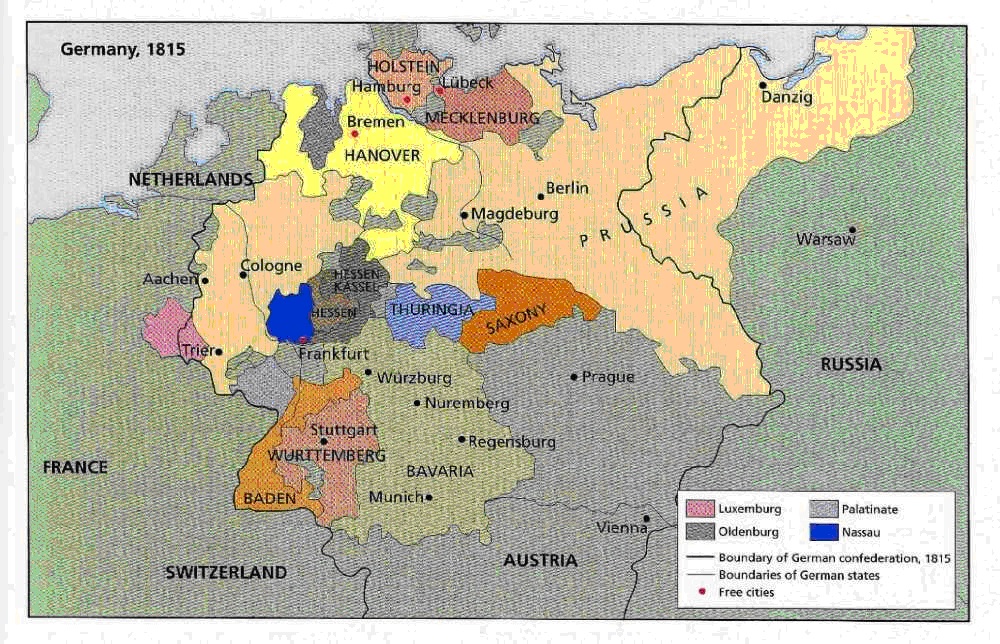
www.rootsweb.ancestry.com/~wggerman/map/germanconf.htm
After Austro Prussian War of 1866

home.zonnet.nl/gerardvonhebel/g1867.htm
Unfortunately, peace was short lived. About two years before Anton was born, the Franco Prussian war broke out on July 19, 1870 and lasted until May 10, 1871. The Austro/Franco-Prussian War articles tell that the North German Confederation sought to annex the southern German states creating a European power with the possibility of inheriting the Spanish throne through the Prussian Prince. France (lead by Napoleon III) disliked the idea of having a neighbor who could possibly ally with Spain and shift Europe’s balance of power. Napoleon III was able to get the prince’s candidacy to the Spanish throne withdrawn, but that was not enough. France wanted an official apology from Prussia and a guarantee that the prince would not accept another candidacy to the Spanish throne. The Prussian King refused, and France declared war on Prussia. The Southern German states quickly joined the Northern Confederation and defeated France (2007). Phillipus and Anne’s oldest son, Leonardus, fought in this war. Based on descriptions of weapons and depictions of battles, it can be assumed that, due to the technology and battle strategy of the time, fighting conditions were terrible (similar to those of the US civil war). Leonardus sent a letter to his family urging his brothers to leave the region before they were old enough to be drafted. According to Geneologer’s (2013) German military records, that age was 20, and it is assumed that Leonardus died in the Prussian army not long after.
So Nicholas, Theodore, Joannes, and Frederick left Schleid and headed for Switzerland. The rest of their journey in unclear, but Robert Behselich & Jane (Behselich) Anderson remember being told that they stowed away on a ship bound for the USA. No record of entry exists for them, and the time and details of their journey are unclear. The first US records that appear are naturalization records for Frederick and Theodore in New Hampton, Chickasaw County, IA. Frederick indicated that he was 22 at the time of his naturalization on December 22, 1890, but according to his birth date, he was 24. Theodore was naturalized on December 13, 1889 at the age of 28.
Frederick
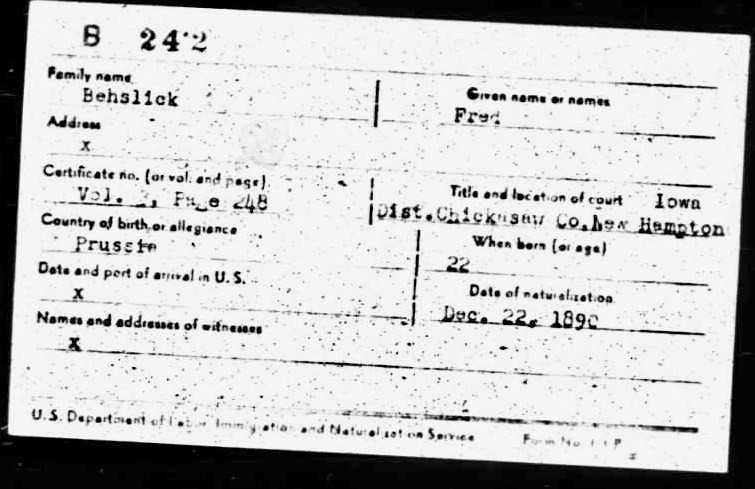
Theodore
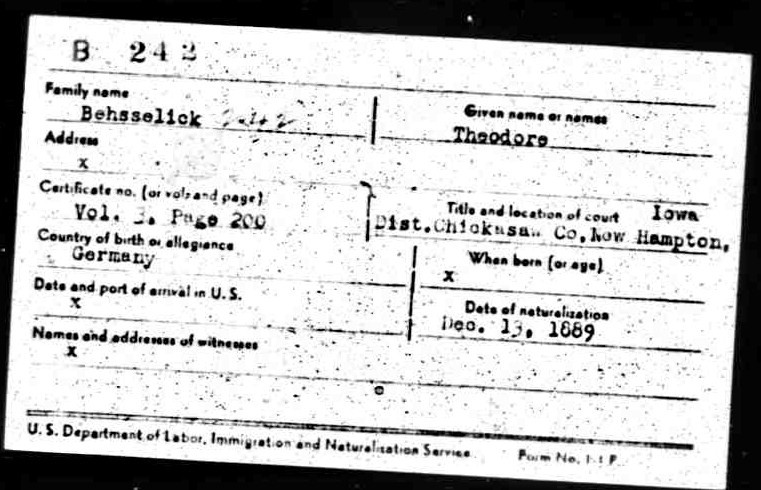
Here the four brothers lived, and “the 1892 land records in Dayton Twp., Chickasaw Co., Iowa, list N & T Behselick (Nick and Ted) as owning 160 acres” (DPBB). They were later joined by their younger brother Anton in 1892. He sailed on the Ship Belgen Land in April of 1892 at the age of 20. Their mother Anne Marie also joined them in New Hampton. She left Hamburg Germany on August 31, 1883 on the ship Normannia captained by Hebich, and she arrived in New York at age 65. The ship record from Ancestry.com lists the travel year as 1893, but there must have been an error when the document was put into the computer because Anne Marie died on September 11, 1891 in New Hampton, Iowa. It is possible that the ink from the 8 could have faded enough to look like a 9. Either way, after she arrived, she traveled to New Hampton to join her sons. She lived there until she died, and she is buried in Calvary Cemetery just north of New Hampton, IA. About a year and a half later, on January 10, 1893, Frederick married Catherine Ellenz in La Crosse, WI. She was the daughter of Hubert Ellenz and Anne Ehlenz, and she was born in Wolsfeld, Germany on June 1, 1873. He met her there while working as a streetcar conductor for the La Crosse City Railway Company (the railway cars were horse drawn). Catherine was working at a sewing company in the city.
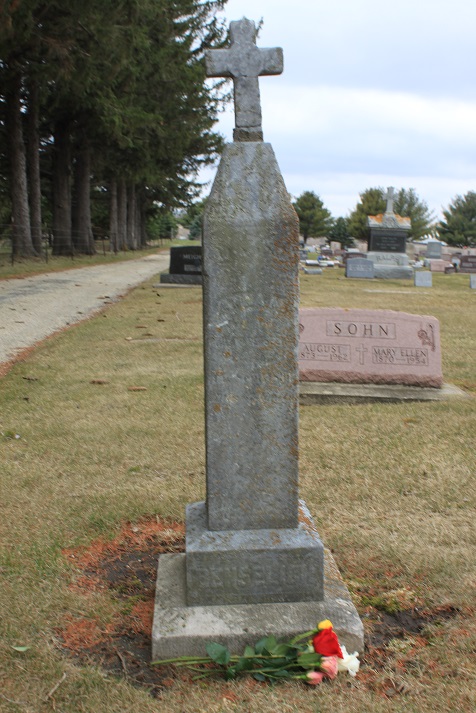
Anne Marie’s Headstone, Calvary Cemetery, New Hampton Iowa
April 23, 2013
Chapter 2
As the years went on, Frederick and Catherine started their family. Their first child (a girl) died not long after she was born. Next came Emma, Anna, Philip, Anton, Susan, Martha, and Theresa; and they were all born in New Hampton, Iowa. Here, in New Hampton, the kids would have German in one class and English in another at school (George Behselich). The DPBB states that “the 1906 County Directory lists Fred Behselick and Mrs. Katie 2 miles west of New Hampton,” and “Nick & Lizzie along with Ted and Emma are listed at 6 miles SW of New Hampton, P.O. Ionia, Iowa.”
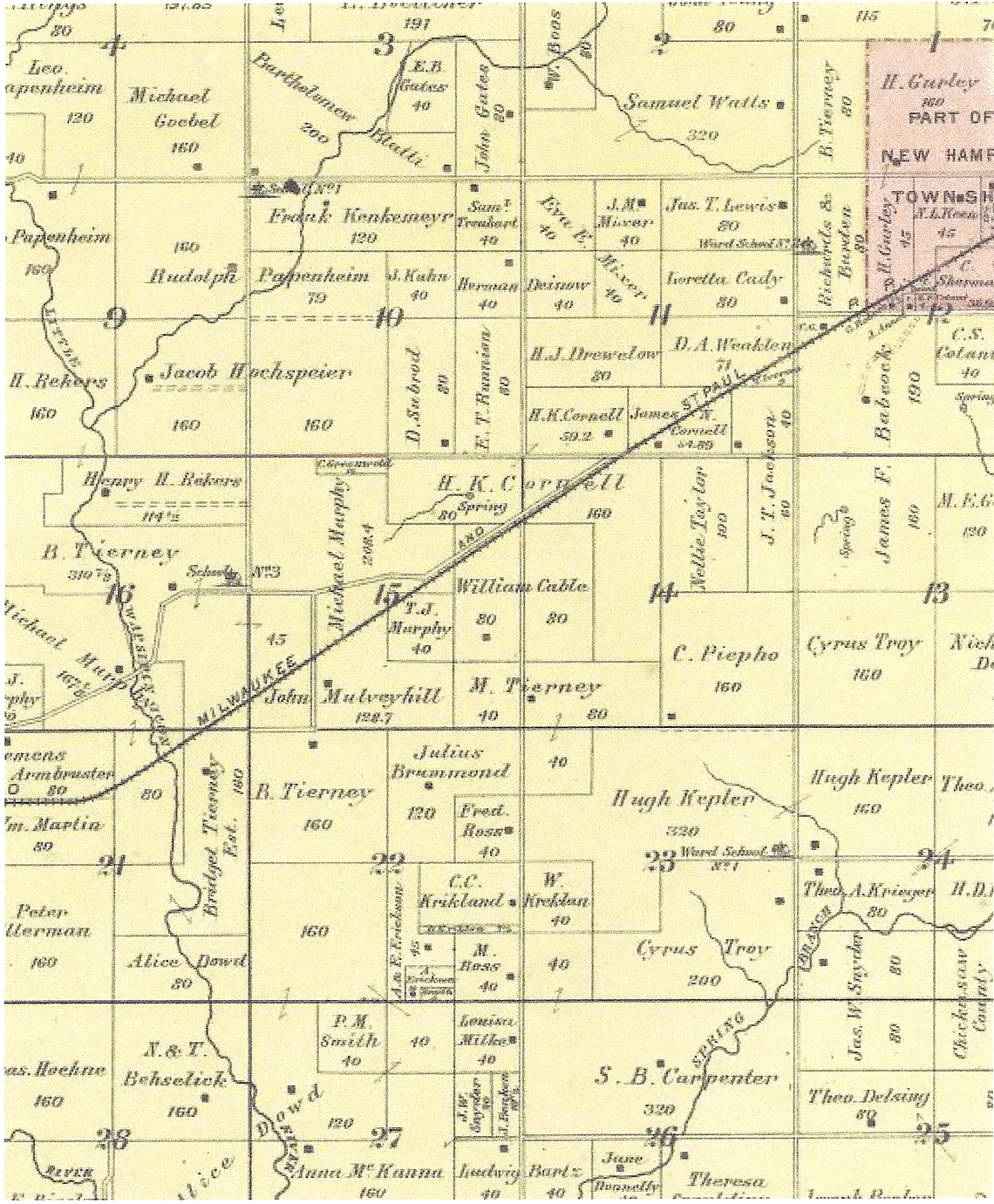
Plat Book of Chickasaw County, Iowa
Eventually, Nicholas, Theodore, Joannes, and Anton all moved to Ipswich South Dakota; but Frederick and Catherine decided to move their family to Pittsville, WI. They had a chance to buy the farm they were living on, but they did not want to take that chance. They moved to WI because the Catholic priest in Pittsville had an ad in the paper in Iowa urging Catholic families to move to WI because land was cheap. Frederick and Catherine wanted to own their own land; so, in 1910, they packed up their belongings, children, colt (a Morgan/Trotting horse cross named Dick), and corn planter, and took the train right into Pittsville, WI. (George Behselich)
They made their way to what is now Ralph Tritz’s Farm at 7772 Sunset Road about 2 miles north of Pittsville. A couple of years later, on December 09, 1913, they bought 200 acres (the original farm) from Michael Rohe (Warranty Deed). Since they didn’t bring much from Iowa, Fred and Catherine had to buy some machinery and cows. The cows came from local farms and the herd included many different and mixed breeds. According to George Behselich, Philip said that when Fred and Catherine bought the farm, there was a “shack” of a house and a barn on the property and on Good Friday, ca. 1914-1915, the house burned down. The older girls, possibly Emma and Anna, were in the upstairs trying to throw the clothes out, but the East wind kept blowing them back in. After the fire, they moved into an old, empty house across the road to the East for a while on what is now Peter and Sally Petersen’s farm.
Sometime later, Frederick and Catherine bought a house that stood East of Pittsville on what is now Jerry Meyer’s hog farm. The living room, downstairs bedroom, and upstairs bedrooms were torn down and rebuilt on the farm. The kitchen, dining room, and store room above were all moved as one piece ca. 1914-1916. They were pulled by horses and rolled on logs down 2nd Ave in Pittsville. When they were parked on the bridge over Cat Creek, Lillian Brown, Philip’s future wife, walked through it on her way to high school, which she attended for two years but didn’t graduate. Little did she know that she would be living in that house one day. Once the house was assembled on the farm, the west doorway that entered into the dining room was made into a window, and the doorway was moved south to enter into the kitchen. (George Behselich)
Around the same time, ca. 1915, the “shack” of a barn that stood where the machine shed is now was torn down. Frederick and Catherine had the first 50 feet of the dairy barn built shortly after that. The driveway to the haymow was also built at this time by Frederick and Catherine with the help of their children: Philip (16), Emma (15), and Susan; and they used field stone that was hauled to the site on a wooden stone boat. The construction on the barn was done by the Haumschilds, and who, at the time, lived in the house that the Romans live in today in Pittsville. One to two years later, Frederick and Catherine had a silo built west of the new dairy barn. The bottom five feet was made of stone, and the rest of it was made of wood. Also around this time, ca. 1915-1920, the East part of the chicken coop was built, and it actually housed chickens. The lilac bushes on the east side of the house were planted, and almost 100 years later, they are still blooming. (George Behselich)
Frederick and Catherine continued to expand their family, and the younger children, Francis, Marie, Agnes, and Laverne, were all born in Pittsville. Lavern was the youngest, and he was born in 1920. This is the same year that the families in South Dakota and Wisconsin decided on a spelling of the family name. In Germany it was spelled Befselich, and the original land records in Iowa have it spelled Behselick. Finally, the Wisconsin and South Dakota families decided to spell the family name Behselich. (DPBB)
A few years later, sometime between 1920 and 1928, Fred and Catherine sold 120 acres to Frank Bear. Frank wanted to put a barn up, but he needed a hill to put it in, so he kept asking Fred to sell him 20 more acres, which he eventually did before 1928 (George Behselich). Years later, on October 13, 1933, Fred and Catherine sold about 3.76 acres of land to the county for the construction of the modern day Highway 80 (Behselich Farm Abstract).
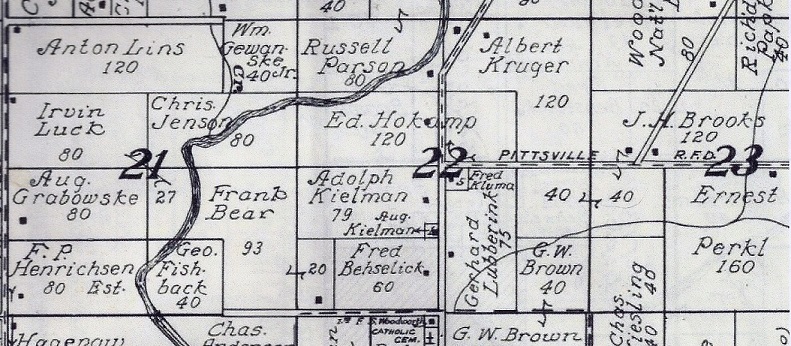
Town of Wood, 1928 Standard Atlas of Wood County Image
The years passed, the children got older, and a couple of them began to reconnect with their relatives in South Dakota. As a teenager, Philip worked in South Dakota on a thrashing crew for the harvest. He stayed with his aunts and uncles who lived out there. He mostly talked about his aunt Emma (who married a Befselich). She was one of the people he stayed with, and he always said that she was a nice lady because she treated him so well. He also mentioned that his younger brother, Anton, had also worked out in South Dakota, but it isn’t clear if they were out there together or not. What is clear is that Philip and Anton would get together and talk about their experiences. They would talk about the terrible blizzards that would bring so much snow that you had to use a rope line from the barn to the house so you didn’t get lost. They would also talk about how the thrashing crews would make stacks of straw out in the fields so if you got caught in a blizzard you could pull the straw from the stack to keep warm. (George Behselich)
Philip and Anton would also talk about the family. While Philip was staying with Emma, one of the relatives out there got a new model-T. Uncle John (possibly) was driving the car around, caught one of the posts under the wrap-around porch on the house with one of wheels, and the porch fell down. Emma said, “John, would you like to drive into the kitchen?” Boy, did he ever get mad. Philip and Anton would also talk about how the old Indian motorcycles of the time would go like a “scared cat”, faster than a car. (George Behselich)
Eventually the children started to get married and move away. Emma married Arthur Hamel on November 22, 1915 at St. Joachim’s Catholic Church in Pittsville. Anna married Mathias Esser August 11, 1925 at St. Joachim’s. Anton married Thelma Brown on July 31, 1922 at St. Joachim’s. Susan married Robert Dowd on November 24, 1925 in Winnebago County, Illinois. Martha married Victor Durand on August 6, 1929 at St. Joachim’s. Theresa married Otto Niemeier on January 10, 1935 at St. Joachim’s. Francis married Arthur Hack. Marie married Alfred Ellie on June 14, 1932 at St. Joachims. Agnes married Peter Esser on October 30, 1939 at St. Joachim’s, and Lavern married Hazel Walton on November 1, 1938.
Chapter 3
Philip wanted to stick around and continue to farm with Frederick and Catherine, so he did. Eventually, he started dating Lillian Brown. She was the daughter of George and Phoebe Brown and the sister of Thelma Brown who married Phil’s brother Anton. The Browns lived in Pittsville, and the family traced their ancestry in America back to shortly after the arrival of the Mayflower – a story that Lillian passed on to her descendents. As time went on, Philip and Lillian got married on May 4, 1921 at St. Joachim’s Catholic Church in Pittsville. They rented the Runo farm that was just southwest of the Catholic cemetery in Pittsville. The buildings stood on a small hill there, and the house was painted bright pink. This is where George, Robert, and Kate were born as well as another girl who was born before Kate and died at birth. At the time, Philip was still helping Frederick and Catherine with their farm.
Around 1929, Philip and Lillian ran above ground water lines to the dairy barn and put in a water storage tank and drinking cups. The water pipes were hooked up to a well that was just west of the base of the haymow driveway, and the well had a hand pump. However, there was not enough water from the well for the drinking cups, so they were not used.
In about 1931, Frederick and Catherine moved into the Runo house and Philip and Lillian moved into the Behselich farm house. It was here, at the home farm, that the rest of the children were born. First came Anna Lee, and then the twins, Jane and Joan, after that. (George Behselich)
When Fred & Catherine switched houses with Philip & Lillian, George was about 9 years old; and they used a lumber sled to haul the furniture. George’s job was to stand on the open porch, hold the screen door open, and hold the team of horses that pulled the sled. Unfortunately, the team decided to run away, taking George with them. When they did, the screen door swung open, and George held on to the reins until they got to where the trailer house in now. He let go, and the team turned west and went around the lumber pile that sat where the well house currently is. After that, they went over the barn driveway, turned north, missed the pole pile, and turned back east completing a circle. It was at this time that Philip ran out to stop them. He was going to grab onto the bit, but the team turned and startled him, making him tumble under the sled. Since it was a lumber sled, the role and bunk sat higher and wider on the runners so there was enough room for him to fit under it. This allowed the team to run over Philip without killing him. Frederick was standing back watching, and after Philip went under the sled he hollered “That’s the end of Phil, that’s the end of Phil, that’s the end of Phil!” but Phil got right back up and ran after them cussing and swearing as they ran across the road and into the snow bank where they got stuck. (George Behselich)
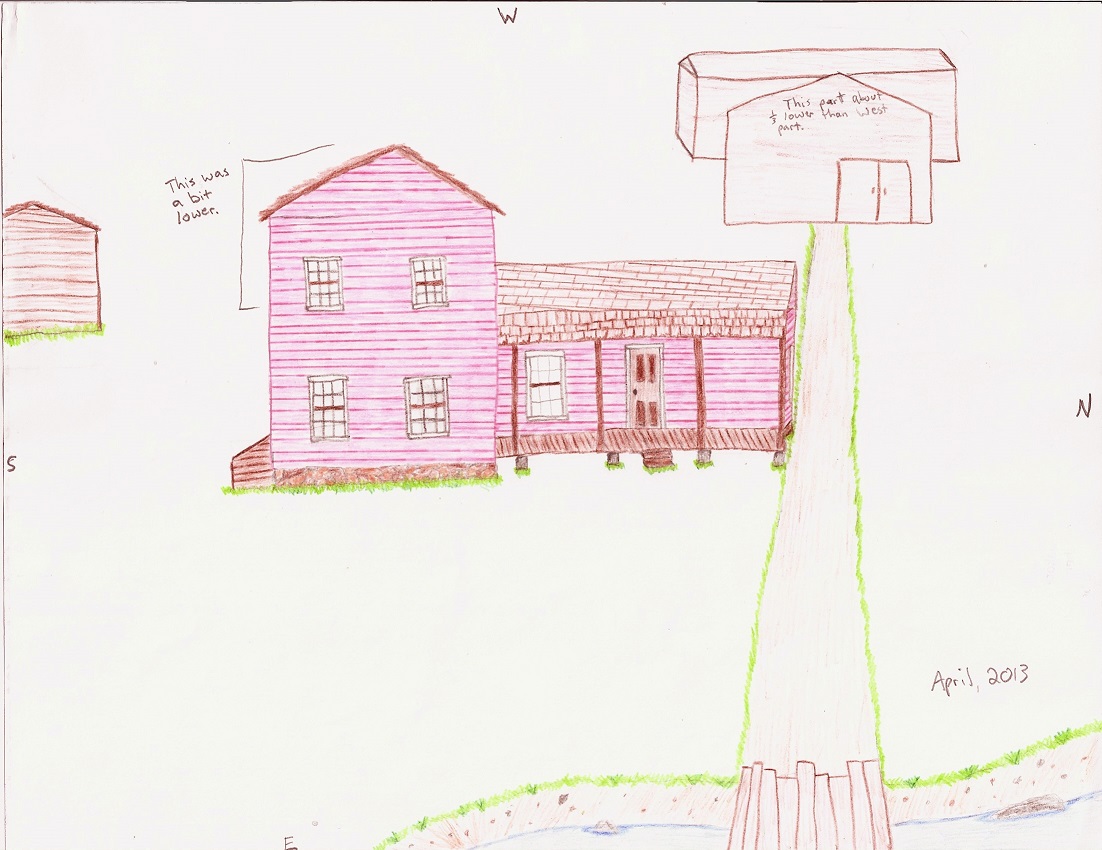
Drawing of Runo Buildings According to George Behselich’s Description – Scott Behselich
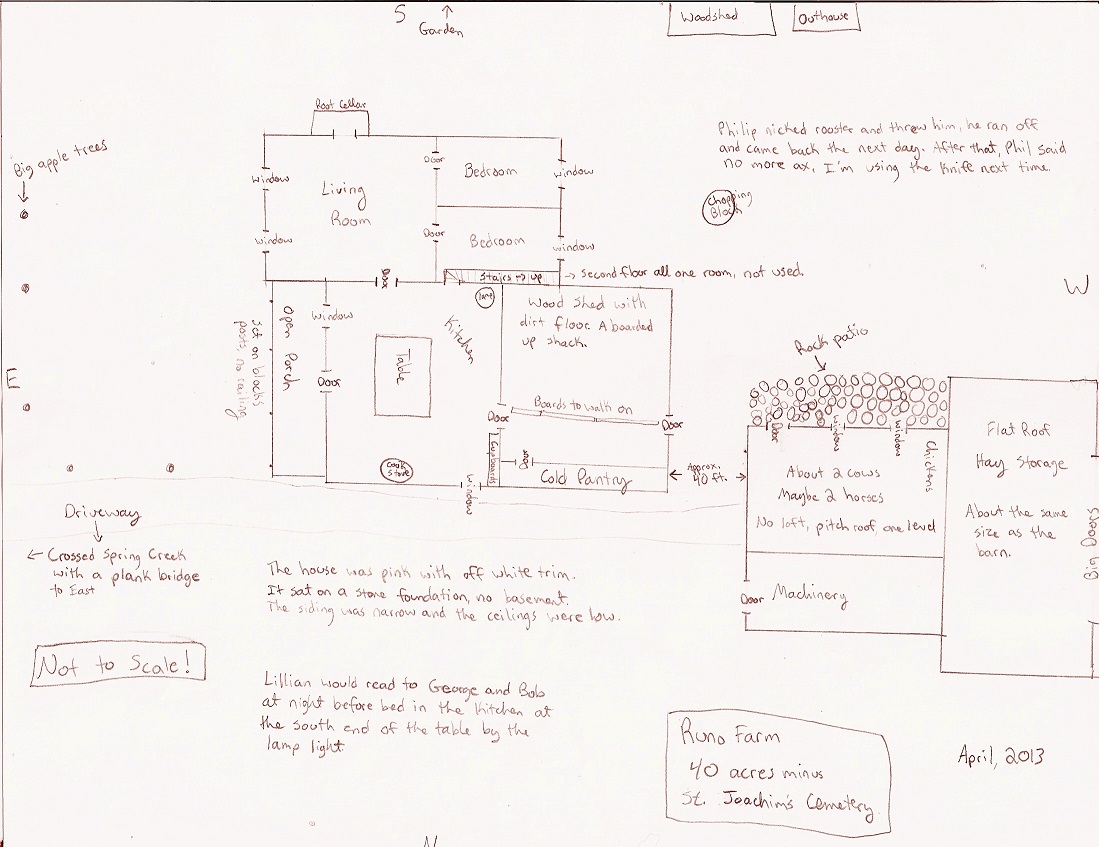
Rough Layout of Runo Farm According to George Behselich’s Description – Scott Behselich
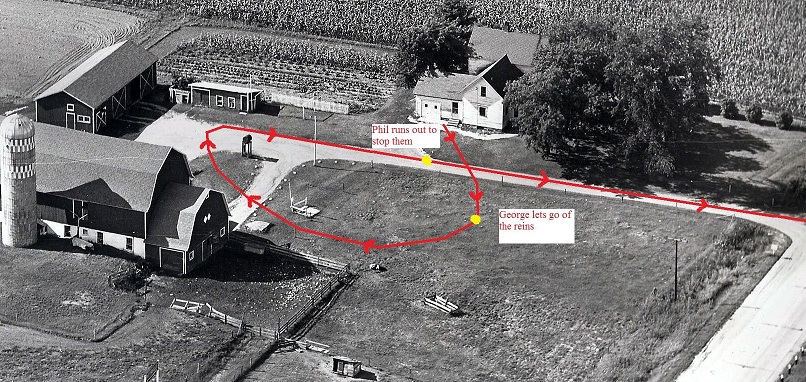
Approximate path of the runaway team of horses.
After this adventure, Fred and Catherine lived in the Runo house for about two years and then moved down to the southern part of the state by Palmyra and Fort Atkinson. They lived there for a couple more years, but they didn’t like it. So they came back to Pittsville and bought a house just north of the UCC Church across the road. They had a garden, a barn in the back with one Jersey cow, pigs, and a few chickens. Eventually, Philip and Lillian bought the farm from Fred and Catherine on February 18, 1936, which by then only included 60 acres or 56 acres (60 acres minus 4 acres for the highway ditches) of useable land of the original 200 acres. (George Behselich)
Now, the team of horses that Philip and Lillian used to move onto the Behselich Farm was notorious for running away, and each time they did, the harnesses broke and had to be patched. Philip and Lillian had to keep them because they couldn’t afford new horses. The mare was nice, but her and Pat would run away at the tip of a hat. Back in the day, they ran away on Fred when he was cleaning the barn out with a manure boat. The horses would pull and steer the boat, Fred would stand at the back and fork the manure out, and the lines would be on a stake on the front end. When the team started to run, Fred managed to jump over the manure, grab the lines, and steer them to a dead furrow and get them stopped. Another time they ran away on George when they were harvesting corn in the West field by Brandt’s. The team started to run, and George grabbed the lines. Philip hollered at him to lace it to ‘em, which he did and made them run up and down the muddy field until they were tired. Later on, Philip managed to raise a nice pair of colts from the mare of this team and he didn’t want to sell them, but a cattle baron offered a lot of money for them, an offer to good to pass up, so he let them go. (George Behselich)
Dick was another horse who lived and worked on the farm. He was the Morgan/Trotting horse cross that Fred & Catherine brought up from Iowa as a colt. He and Philip basically grew up together. After Philip & Lillian moved onto the farm, George would also have to spend a lot of time working with him. He could be used to pull heavy things or as a trotting horse. The fall after George graduated from eight grade in 1936, he was 14 years old and he used Dick and another horse, Pat, to plow a 9 acre strip of field north of the house. George used a single bottom, 14 inch, walk behind plow that turned 27 inches of sod on each pass. The work was slow. He plowed about 2 ½ mph, and had to take a 5 minutes break for himself and the horses once he reached each end of the field. Dick and Pat were used in the afternoon, and Pat and Shorty were used in the morning. George had to plow this field by himself because Philip starting working on the town and county roads hauling gravel for some extra money that spring during the depression, and George was the oldest of the children. It was also during this time when George was plowing the field that Dick got the heaves, so George took him out into the field just west of the dairy barn to walk him and make him feel better, but it was no use. Dick died right there in the field that day, and that is where he is buried. George said that was the only time he saw Philip tear up, and they had to get another horse so George could finish plowing the field. (George Behselich)
Horses weren’t the only source of transportation for Philip and Lillian. In about 1926, they bought their first car, a Model T. They used that when they could until they bought a different car later on. (George Behselich).
In ca. 1939-40, Philip and Lillian bought the Runo farm for approximately $750. Then, Philip and George set out to make some improvements to the farm; and later, in about 1943, Philip and George tore the Runo buildings down and used the lumber to build the machine shed on the home farm, and the garage on the house. The wall paper from the Runo house can still be seen on boards in the shop and oat bin on the south side of the shed, and the wide roof boards of the shed came from the Runo buildings. The rafters in the shed were sawn from lumber in the woods from the farm. A couple of the windows from the Runo house were put between the house back porch and garage. Also in 1940, the well just northeast of the dairy barn was drilled. The aboveground water lines were hooked up to it, and there was finally enough water for the drinking cups. (George Behselich)
About the same time, Philip and George also dug out the basement under the kitchen by hand, and Philip and Lillian had electricity put in. Philip and George cemented the shelves and knocked a hole in the wall to the rest of the basement to make a door. There was a stone in the ground in the doorway that wouldn’t budge. They pounded and pounded on it with a mall, but eventually they just cemented around it. The electricity was put in ca. 1942-1943 during the war. Before then, Philip and Lillian couldn’t afford the $4.00 a month for it. The house and buildings were wired by Mathias Esser, Philip’s brother-in-law. Some of the original wiring is still in use. (George Behselich)
Also around this time, ca. 1943-44, Philip and Lillian bought 64.2 acres of land between the Yellow River and Pittsville City limits south of modern Highway 80 from Gerhard Lubberink. One day, Philip and George were using dynamite to clear out some tree stumps down by the river where there used to be a lot of trees, more than what there is now. Philip told George that they should take a large oak tree out that was in the field. So, they cut it down, and Philip said “that’s a big one”, as he looked at the stump; “we better load it up good.” They put 8 sticks of dynamite underneath it. When it blew, it went way up and left a big crater in the ground because dynamite blasts down first and then up. Now, at the time they were doing this, there was a man fishing in the river near the place they blew the stump out, and a chunk landed in the river near him. When it did, he came tearing out of the river and said something that resembled: “What in the world is going on here, that chunk almost hit me!” Philip and George were both surprised because they didn’t know anyone was there. They also used dynamite to blast the top off of some bedrock in the field northwest of the house up on the hill. (George Behselich)
One day, around this same time, Philip and George were putting fence posts in around the west field by Brandt’s. There was hay there at the time, and Phil wanted to pasture the cows on it. When they were working at the southeast corner of the field, Philip was holding the fence posts and George was pounding them in with the mall. On one swing, George hit the post at an odd angle, and Philip’s left arm slid forward. When it did, it pulled about four inches of skin back from the inside of his elbow up his arm exposing the muscle. Phil put the skin back, and George laughed a bit not realizing what happened. Philip looked sick and felt faint, and George finally saw that the skin had been peeled back. So he helped Philip walk back up to the house. Lillian cleaned out the wound, put Watkins salve on it, bandaged it up, and it eventually healed. A few years later, in ca. 1947, underground water lines were run from the well to the dairy barn and the house.
Later on, in 1948, the stave silo on the south side of the barn was put up. Also during this year, Philip and Lillian got indoor plumbing. Up until this time, they used an outhouse that was located where the clothesline is now. There was also a smoke house that Fred and Catherine built that sat just north of the outhouse where the garden is now. Philip would have to lock the dog in there when he was blasting tree stumps out because the dog would steal the sticks of dynamite from under the stumps before they went off. Philip tore down the outhouse and smoke house not long after they had plumbing put in the house. (George Behselich)
Then, a couple of years later, in the spring of 1950, Philip bought a 1949 WD 40 Allis Chalmers tractor and cultivator. He traded in an Allis Chalmers Model C. He bought them from Orgel’s Garage, a Ford dealership in Pittsville that was in the empty lot across from Laura’s Corner Cafe that also sold Allis Chalmers equipment. The Allis has been overhauled twice, and it is still used today. A year later, in 1951, the milkhouse was added onto the dairy barn.
Also in the 50s, Philip and Lillian had the furnace put in the house, and they sold some sand to the state for the construction of modern Highway 80. They were paid 10 cents a yard. The sand came from the land they owned by the yellow river. They took the $6,000 and used it to add on to the dairy barn in the summer of 1955. The old stone and wood silo on the west end of the barn was torn down, and the west addition was put on. Philip and George formed the basement walls on the inside but used the ground on the outside as a form. They shaved the edges as smooth as they could. Concrete was poured up to ground level and blocks were used to get the rest of the height. (George Behselich)
One or two years later, they had the manure shed added on to the east side of the dairy barn, and the west part of the chicken coop was added on in the late 50s after the manure shed was built. When the manure shed was being added on, Phil and Lillian had the inside of the barn switched around. Originally, the cows faced in towards the alley way. Phil and Lillian made it so the cows faced outward towards the walls. During this time, they had to milk the cows by hand outside in the yard, and it was a rotten pain in the backside. Interestingly, the cows were all milked by hand until 1955, a couple of years before the additions. That is when Phil and Lillian got surge buckets. The milk went into the surge bucket and then it was dumped into milk cans. (George Behselich)
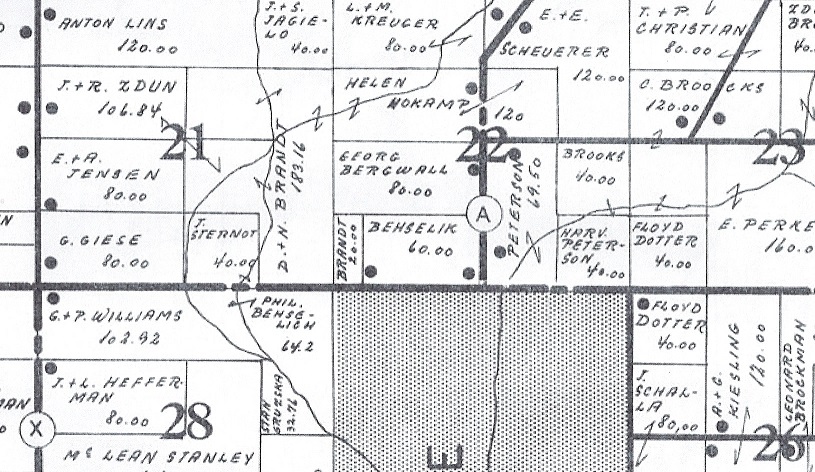 Official County Plat Book and Rural Directory of Wood County, WI 1956
Official County Plat Book and Rural Directory of Wood County, WI 1956
One or two years later, they had the manure shed added on to the east side of the dairy barn, and the west part of the chicken coop was added on in the late 50s after the manure shed was built. When the manure shed was being added on, Phil and Lillian had the inside of the barn switched around. Originally, the cows faced in towards the ally way. Phil and Lillian made it so the cows faced outward towards the walls. During this time, they had to milk the cows by hand outside in the yard, and it was a rotten pain in the backside. Interestingly, the cows were all milked by hand until 1955, a couple of years before the additions. That is when Phil and Lillian got surge buckets. The milk went into the surge bucket and then it was dumped into milk cans. (George Behselich)
George can still remember back to about 1936 and 1937 when they milked by hand and hauled the milk to the cheese factory in Pittsville. George would ride along with Lillian, and Dick would pull the wagon. The factory was located where Laura’s Corner Cafe is now. This was the way it was until 1937, when they bought the 1937 Chevrolet. Then they used the car and a trailer to haul the cans to the factory in town until the factory blew up. (George Behselich)
George was the only one of Philip and Lillian’s six children who wanted to farm. He started farming after he finished eighth grade and he never attended high school. He continued to farm for the rest of his life. His siblings got married and moved away. Robert moved to Milwaukee after he graduated high school to get a job; and later on, he married Darlene Holseth on June 28, 1945 at St. John’s Catholic Church in Marshfield, WI. Kate married William Schroeder on June 17, 1948 at St. Joachim’s, and they eventually moved to Palmyra, WI. Anna Lee joined the convent to become a nun, but she never took her final vows. She married Thomas Hagen on November 29, 1966 at St. Joachim’s. Jane married Donald Anderson on October 7, 1961 in Marshfield, and Joan married Martin Bleik on May 8, 1959 at St. Joachim’s.
.jpg)
1949 WD 40 Allis Chalmers Tractor
Chapter 4
While George was farming with Philip, he met Geraldine at a dance at the Richfield town hall in 1944. It was a brick building that stood where the Richfield fire station is now. One Sunday, they were making hay to get it in before the rain. George always bragged to Geraldine that they never worked on Sunday, but on that particular Sunday, Geraldine and her family decided to stop down for a visit. Boy, was George ever embarrassed. Since they were working on Sunday, George had to go down to the bar to get some beer for everyone. George and Geraldine lined up the empties and had their picture taken in front of the lilac bushes. (George Behselich)
George and Geraldine were married on June 1, 1946 at Sacred Heart Catholic Church in Marshfield, WI. Right after they were married, they lived with Philip & Lillian on the farm. It was around this time that Philip & Lillian had the front (East) porch put on, and George and Geraldine used it as their entry way into the farm house. George and Geraldine lived in the living room and downstairs bedroom for five years, and Philip & Lillian had the kitchen, dining room, and upstairs bedrooms during that time.
Interestingly, Geraldine did not know how to cook when she married George. Growing up, she would spend most of her time outside and in the barn with the animals. So, after she got married, she had to learn how to cook and bake, and the first few years may have been a little rough. All of that practice did pay off, though; and she still cooks and bakes bread and cinnamon rolls. (George and Geraldine Behselich)
This timeframe is also when Dennis, Don, and Charlotte were born. After these first five years, George and Geraldine moved to a farm on the Polish Road and lived there for five more years. This is when Colleen, Analee, and Paul were born. George and Geraldine moved again in 1956 to a farm near Sherry, and their son Mark was born shortly after. They lived there for four years; and during this time their son Phillip was born in January of 1960. A week later, George’s dad, Philip, died; and a few months later George and Geraldine moved back to the home farm. (Family Tree Book, George Behselich)
It was April 29, 1960 when George and Geraldine bought the farm from Lillian. At this time, the farm consisted of the 60 acres from the original 200 acres, the Runo farm, and the 64.2 acres by the Yellow River. When they bought the farm, Lillian moved into a house in Pittsville. It was while living on the home farm that the rest of George and Geraldine’s eleven children were born. After Phillip came Lynette, Joseph, and finally Alan. Two years after buying the farm, in 1962, George and Geraldine had the bulk tank put in the milkhouse. They started out with all Holstein cows, but as time went on, they were gradually replaced with Guernseys. George and Geraldine liked the breed better and they were smaller than the Holsteins, so they fit in the stanchions better. (George and Geraldine Behselich)
That same year, Geraldine’s father remodeled the inside of the house. He opened up the walls between the kitchen and the dining room, and between the dining room and the living room. He also closed up the doorway from the front porch into the living room, and he straightened the stairs. Instead of having them turn and go into the dining room, he made them go straight down into the living room. (George and Geraldine Behselich)
Also in the early 60s, the big picture window on the east side of the living room was put in. It came from the Stardust Motel on the south end of Marshfield. Geraldine’s brother, Hilmer and his wife, owned the motel at that time and they were remodeling. That is how George and Geraldine came by the window. (George and Paul Behselich)
From about 1966 to 1980, George and Geraldine were members of the National Farmers Organization, which is an organization that helps farmers pool their products together to gain a marketing edge. The meetings would mostly be held in the basement of the bank in Auburndale, and sometimes they would be held in Pittsville and other places where they could get a hall to use. After being a member for two years, George began serving as the county president for the local chapter of the organization, and he continued to do so for 12 years. Then, in ca. 1969, George and Geraldine had the NFO letters put on the south side of the dairy barn, and they have been there ever since. (George Behselich)
Growing up, the older kids would have to help with chores on the farm. The older girls would do the dishes and take care of the younger children, and the older boys would help in the barn and the fields. Although Geraldine did all of the cooking and most of the house cleaning, she spent quite a bit of time helping George in the barn. When the children were really small, she would even take them in the barn in a buggy and watched them while she milked the cows. (Behselich Family Conversation)
Geraldine always liked working with the animals and preferred to do barn chores. Growing up, she developed a love for horses and wide open spaces. When she was young, Geraldine would take the work horse down the road by herself, but he would only go so far and then he would turn around and go back home. She also loved to drive a team of horses. (Geraldine Behselich)
On March 20, 1964, George and Geraldine sold an eight acre parcel of wooded land on the Yellow River to William and Mary Ann Suchow. Then, a few months later on September 29, 1964, they sold Suchow’s another small wooded parcel of land along the Yellow river. (Behselich Farm Abstract)
A year later, in 1965, George and Geraldine’s oldest son, Dennis, joined the army and headed off to Vietnam for two tours, and they had the cement at the top of the haymow driveway put in that same year. Lynette and Phillip put their footprints in it, and they can still be seen today. Two years later, in 1967, Don joined the Army and served in Italy for three years. Then, in 1968, Charlotte married Bill Bray at St. Joachim’s Catholic Church in Pittsville; and in 1970, they bought the sand pit from George and Geraldine and built a house on land by the Yellow River, which they eventually sold to Paul in ca. 1975-76 and moved into a house in Pittsville. (George and Paul Behselich)
Eventually, Lillian got tired of living in town and she wanted to move back to the farm. So, in 1969, she sold her house in town and bought a mobile home to put on the farm. It was put just south of the driveway and close to the road, and it has been there ever since. Then, in ca. 1970-71, George and Geraldine had new siding put on the house. (George Behselich)
The next year, in 1971, Don married Catherine Grobe on June 5. A month earlier, Colleen married Raymond Schwanebeck on May 1; and on September 29, 1971, they bought some land from George and Geraldine by the yellow river. Here they built a house and shed for Ray’s trucking business; and on August 19, 1976, they bought another 1.56 acres from George and Geraldine. However, Colleen and Ray sold this land and moved. (Family Tree Book)
George and Geraldine weren’t all about selling land. In 1972, they added about 75 acres to the farm which they bought from Schmeider’s and was located just east of the home farm between modern day highway 73 and Hilltop road. This is where Paul kept his gilts, which he bought in 1971 to start his hog operation. They also bought 2 small Leyland tractors that year. (George and Paul Behselich)
The other children began to get older, and one in particular took an interest in farming. George and Geraldine’s sixth oldest child, Paul, joined the farm after he graduated high school as a partner with George in 1973. The partnership just included personal property; George and Geraldine were still the only owners of the land. During that first summer, they built the hog barn. This was the first version, and it was built as an uninsulated poll building they designed themselves for finishing pigs to be sent to market. It was open to the south, the inside had cedar posts with hog wire to make the individual pens, and the cleaning and feeding were done by hand. Later that year in September, George, Geraldine, and Paul sold the cows. (Paul Behselich)
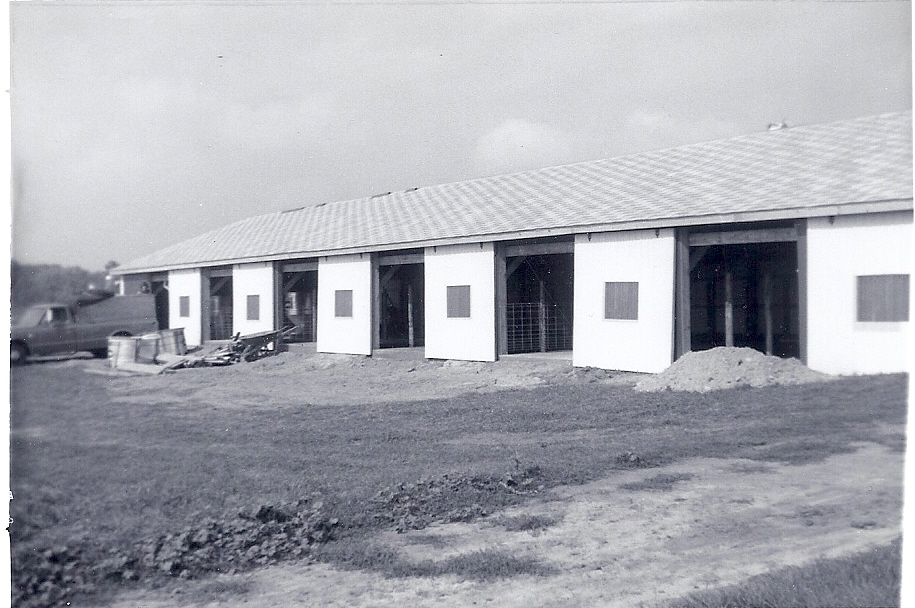
Hog Barn being built in October 1973
The following year also brought some more changes and additions. Starting in late 1973 and finishing in 1974, George and Paul remodeled the dairy barn. They took the stanchions out, raised the floor about two inches with concrete, and added farrowing crates. Sows were put in the crates, and the farrowing operation was underway. Paul also bought a K Gleaner combine that year and started a custom combining business that summer. The small grain bin, the one that is furthest to the north, was also built that year. This was also the year that Mark married Julie Horn in August, and Dennis bought a cattle truck and trailer from a man by Sherry to start hauling livestock while he was serving in the Wisconsin National Guard. Paul would haul livestock when Dennis wasn’t around. It was a good way to meet people from all over Wood and Portage counties. Then, in 1975, George and Paul traded the small Leyland tractor for an 1105 Massey Ferguson tractor with a cab. (Paul Behselich)
In January of 1976, George and Geraldine bought approximately 52 acres just west of the modern day Cenex Truck Stop from Marie Lipka. Later, in the spring, Dennis joined Paul and George as a partner. With George and Geraldine, Paul and Dennis began to make some changes to the farm. They bought a second 1105 Massey Ferguson without a cab and a corn dryer. This is also the year that Paul started his grave digging business. It was a rough year as well. They planted 400 acres of corn, but the summer brought a drought. A saving rain came during the third week of July, and they averaged 75 bushels of dry corn per acre. (Paul Behselich)
The next year wasn’t much better. As things started out in 1977, they looked promising. Spring came very early. People started plowing their fields at the end of February, which is unheard of around here. The partnership farmed 500 acres, and the corn looked good up until August when the rain started in. It rained until the rain turned into snow. Everything was so wet and covered in snow they lost 100 acres from not being able to harvest it. This was also the year that the second, or middle, grain bin was built, and the partnership got tired of the hassles that farrowing brought. So, they went to strictly finishing hogs. (Paul Behselich)
This change in direction prompted changes being made to the hog barn starting in 1978. Paul, Dennis, and George took a trip down to Iowa to look at the different outbuildings for hogs. When they came back, they made up their plans and started work in December. First, they put the pit in the center underneath the barn. Next, they added the cement block walls, the feed bins, and the auger system. Finally, to solve the problem of things freezing up in the winter time, they closed up the south side and added insulation. The work was finished in about March of 1979, and they had pigs in the building by the end of that month. Earlier, in 1978, the grain elevator, wet bin, and concrete cross auger were added to the farm. George, Dennis, and Paul drove to the southern part of Wisconsin and to Minnesota to get ideas for building them. It was a long way to go, but those were the closest places that had grain elevators. When the system was finished, it was the first and only one of its kind in all of central and northern Wisconsin. The year of 1979 brought a late, wet spring, a cold summer, and poor corn crop compounded by expensive fuel due to Russia invading Afghanistan. (Paul Behselich)
The other children didn’t share an interest in farming; and, in time, they got married and moved away. Lynette got married on August 19, 1977. Phillip married Linda Turnbull on November 13, 1981. Analee got married on September 10, 1982. Joe got married on May 5, 1990, and Alan got married on May 14, 1994. (Family Tree Book)
Chapter 5
Paul married Susan Engelman on May 3, 1980 at St. Joachim’s Catholic Church in Pittsville, and they moved into the double wide mobile home that Paul had bought from Charlotte and Bill back in ca. 1975-76. This was a good year that brought an early warm spring and a good corn crop. While Paul and Sue were living in the double wide mobile home, Jason, Jeremiah, and Angie were born; and Lillian moved out of the mobile home on the farm and into Marshfield in ca. 1981. George and Geraldine then rented the mobile home out for a year during 1982, and the last, largest, grain bin was built. The concrete was mixed on sight, but the company got the mix wrong by adding too much sand and the base is now crumbling. Also around this time, George and Geraldine sold the 75 acres from the Schmeider farm, and Joe joined the Army that year. He served 20 years in the Army National Guard. (George and Paul Behselich)
In March of 1983, Paul and Sue moved into the house on the farm; and, while here, Jeffery, Brian, Kate, and Scott were born. When they moved into the main house, George and Geraldine moved from the house into the mobile home. Dennis stayed in the main house with Paul and Sue until the end of that year when George and Geraldine moved to Texas on December 31. After that, Dennis moved into the mobile home, and Alan lived there with him for a while. Paul started working in the paper mill in Nekoosa on October 24 of that year. Lynette and Dan rented the house Paul and Sue moved out of for a while, and then Paul and Sue sold it in 1984. (Paul and Sue Behselich)
During the 80s, the agricultural economy went into a massive depression, and it became cheaper to buy grain instead of producing it yourself at a loss. So, the partnership sold all of the machinery at auction except the Allis Chalmers tractor and Paul’s F gleaner combine in the spring of 1984. Paul kept the combine until September of that year when he stopped his custom combining business and sold the combine. (Paul Behselich)
The next year, Dennis, Paul, and Sue bought the farm from George and Geraldine on December 19, 1985. At this time, the farm consisted of the 60 acres from the original 200 acres and the 40 acres that were left by the Yellow River because earlier that year, the partnership sold the 52 acres from Marie Lipka and the 36 acres from the Runo farm. (Paul Behselich)
Paul and Dennis continued to feed hogs, and Dennis became a truck driver for a company in Wisconsin Rapids. They would average 1500 head per year while feeding continuously in both the dairy barn and the hog barn until 1990. In that year, they cut back to about 1000 head per year, and they continued this way until 2006. During that time, in ca. 1994, Dennis became Michael Edwards’ big brother, and Paul and Sue planted the hard maple trees in the front yard. A year later, in 1995, they planted a couple of apple trees east of the dairy barn. Then, in 1997, the fans in the hog barn stopped working overnight, and nearly all of the pigs in the barn died from overheating. In 2003, a new underground water line was put in from the well to the dairy barn. Then, after 2006, Paul and Dennis just fed two groups of about 200 pigs each in the hog barn and left the dairy barn empty. (Paul and Dennis Behselich)
The empty dairy barn was still used by the kids to house fair pigs. The pigs were kept in a pen on the north side of the barn, and they were fed by hand. When the pigs were old enough, they would have to be walked and worked with so they wouldn’t run wild at the fairgrounds. The kids would start by walking the pigs up and down the alley in the barn every day; and, once they were trained well enough, they would be walked outside and down the lane to the marsh. Some years, the pigs were trained so well that all you had to do was let them out and they would walk out of the barn, down the marsh, and back into the pen on their own (with a little supervision of course). Meanwhile, George and Geraldine moved from Texas to Arizona in 1991 for 10 months. After this short stay, they moved back to Wisconsin in 1992 because that was where most of the family was. First, they moved to Wisconsin Rapids, and they were they were there for three years. After that, they bought a mobile home and lived in Pittsville for four more years. Then, in 1999, they moved back to the farm and lived in the mobile home with Dennis. Except for a short stay in the Nancy Nye Villa in Pittsville due to Geraldine’s knee replacement, they have been there ever since. (George and Geraldine Behselich) Lillian also did some moving. In the mid 1990s, she moved from her apartment in Marshfield to the Marshfield Living center. She lived there until she died on September 7, 1999; she had just turned 99 a month earlier. (Family Tree Book)
While living on the farm, George and Geraldine enjoyed staying busy, and they wanted some chickens to take care of and to have eggs to sell. So, in ca. 2005-06, George, Paul, Dennis, and Scott remodeled the dairy barn to house chickens because the chicken coop was full of lumber and Sue didn’t want the chicken smell next to the clothesline. Pens were made on the south side of the dairy barn, roosts were put up, and nesting boxes were installed. George and Geraldine would feed the chickens and collect, wash, and sell the eggs. Paul, Dennis, and some of the younger children would keep the pens cleaned out. Eventually, though, George and Geraldine got too old to handle all of the work. So, Sue and some of the children kept up with taking care of the chickens and selling the eggs. Every couple of years, when the egg production goes down, the chickens are sold and pullets are bought to replace them, and today, the birds are still in the barn laying eggs.
Paul and Sue’s children grew, they graduated from high school; and some went on to graduate from college. Others got married and started their own families. In 2005, Brian joined the Marines, and he served in Iraq at Camp Fallujah from 2006-2007 and in Afghanistan in 2009. Michael Edwards also became a part of the family. He lived with his grandmother; but, starting in about first grade, he would ride with Dennis in the semi across country during the summer and sometimes during the school year. He would read the map, plan the routes, and talk about the military with Dennis. Overtime, he became more of a son to Dennis and a part of the family. As the time for the farm’s 100th anniversary began to draw near, Dennis, Paul and Sue began to make plans for a grand family reunion to include all of the descendents of the first Behselich owners of the farm, Frederick and Catherine. In 2011, Jeremiah, Jeffrey, Brian, and Michael painted the grain bins and grain leg. The stone wall for the barn driveway was also saved and repaired that year. In 2012, the electrical lines were put underground and Scott scraped the shed, dairy barn, and chicken coop and pressure washed the hog barn. Then Brian and Scott painted these buildings. 2013 brought the addition of pavement block walkways and a patio, the replacement of the fence on the northeast side of the dairy barn, and the final preparations for the 100th anniversary.
.jpg)
Brian, George and Paul Behselich inspecting the wall
.jpg)
Scott and Brian Behselich working on the walls
.jpg)
Trenches to run electrical wires underground
Today, the farm consists of 60 acres of the original 200 acres, plus 36.9 acres by the Yellow River, and it is still being used. Paul and Dennis are still raising butcher hogs, and the neighbors rent some of the land for crops. The buildings have been repaired, and the final preparations for the Century Celebration this summer are well underway!
Sources
Chapter 1
Allen, Tom et al. “History of Modern Europe 1792-1878, by C. A. Fyffe” The Project Gutenberg eBook of
History of Modern Europe 1792-1872, by C. A. Fyffe. Release Date: 4 Sept. 2004. Ebook # 6589.
Updated: 31 Jan. 2004. Web. 11 April 2013.
<http://www.gutenberg.org/dirs/etext04/8hsmd10h.htm>
Ancestry.com Name Index. freepages.rootsweb.ancestry.com. Ancestry.com. Web. 11 April 2013.
<http://freepages.genealogy.rootsweb.ancestry.com/~eifel/pick/index_0027.html >
Descendents of Phillipus Befselich Book (DPBB)
Fyffe, Charles A. “Austro-Prussian War 1866.” International World History Project. 2007. Web. 11 April
2013. < http://history-world.org/AUSTROPR.htm>
George Behselich. Personal Interviews. 2012-2013.
“German Genealogy: German Military Records.” Genealoger: Family History and Genealogy Services.
2005-2013. Web. 11 April 2013. <http://www.genealoger.com/german/ger_military.htm>
Image. Rhineland – Palatinate, Germany. August 27, 2012. Web. June 24, 2013.
https://commons.wikimedia.org/wiki/File:Rhineland-Palatinate,_administrative_divisions_-_de_-_colored.svg#file Free Use License. https://creativecommons.org/licenses/by-sa/3.0/deed.en
“The Franco Prussian War.” International World History Project. 2007. Web. 11 April 2013.
<http://history-world.org/franco_prussian_war.htm>
Chapter 2
Behselich Farm Abstract. Section A. Pages 10, 18, and others.
Descendents of Phillipus Befselich Book (DPBB)
George Behselich. Personal Interviews. 2012-2013.
Image: Library of Congress. Plat Book of Chickasaw County, Iowa. North West Publishing Company.
Image: University of WI/Digital Collections. The State of WI Collection: Standard Atlas of Wood County. 1928.
Web. Page 31. 18 April 2013.
Warranty Deed. Number 113443. Volume 93. Page 25.
Chapter 3
George Behselich. Personal Interviews. 2012-2013.
Image: Official county plat book and rural directory of Wood County, Wisconsin. Farm Plat Book Publishing
(Manakato, MN). 1956. Web. The State of Wisconsin Collection UW/DC. PDF File. 18 April 2013.
Chapter 4
Behselich Farm Abstract. Section F. Pages XVIII; XXV.
Family Tree Book. Descendents of Frederick Behselich and Catherine Ellenz.
George, Geraldine, and Paul Behselich. Personal Interviews. 2012-2013.
Chapter 5
George, Geraldine, Dennis, Paul, and Sue Behselich. Personal Interviews. 2013.